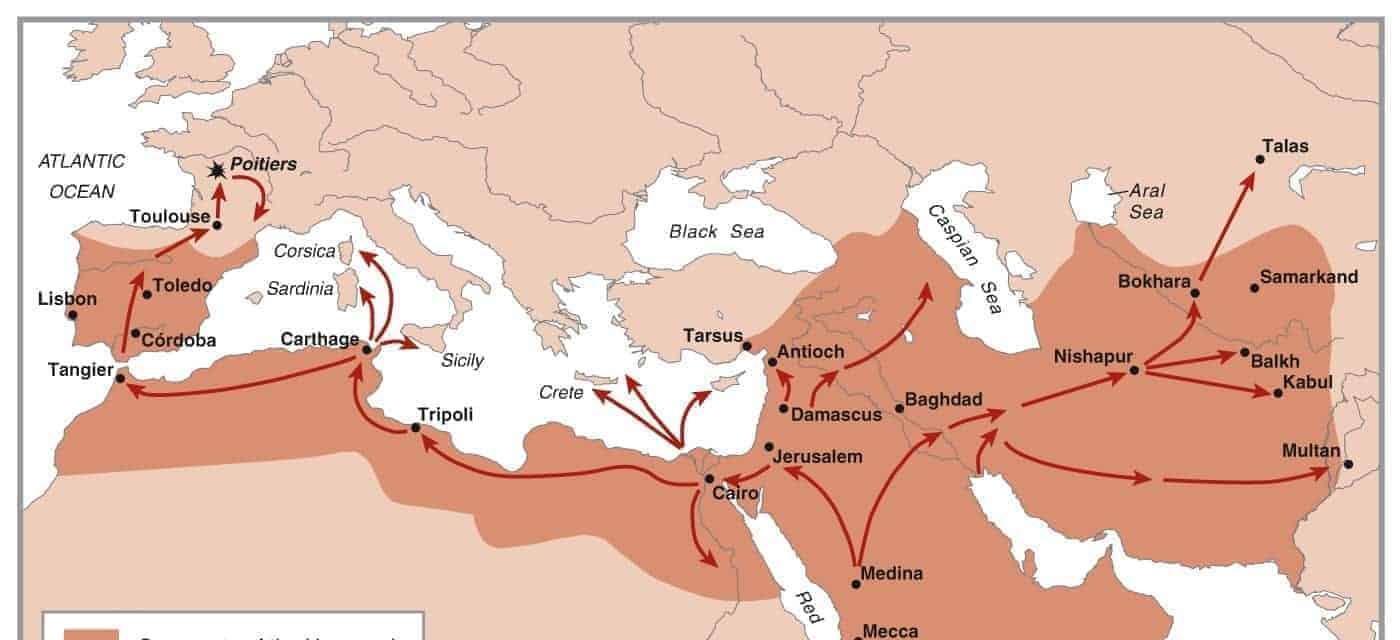Although early sources are not completely reliable, most historians acknowledge that Islam originated at the beginning of the 7th century in Medina and Mecca. The Prophet Muhammad is the most famous figure in Islam, and in historical terms he is recognized as a political, religious, and social reformer and is credited with the foundation of the Islamic civilization. He united Arabia into one single Muslim polity and ensured his teachings and the Quran formed the basis of the civilization’s religious belief.
Approximately three years after receiving his first revelation from God, Muhammad preached these revelations to anyone who would listen but met initial hostility. However, he overcame this resistance and took the city of Mecca in 629. Muhammad died in 632, but by then a large proportion of the Arabian Peninsula had converted to Islam. Upon the death of Muhammad, Abu Bakr became the first of four Caliphs to govern the Islamic state. These men are often known as the Rashidun (rightly guided) Caliphate and were in charge for the first Islamic conquests.
The assassination of Uthman ibn Affan in 656 was the spark for the first Islamic civil war. His killers supported the next caliph, Ali ibn Abi Talib, who was Muhammad’s cousin and son-in-law. Muawiyah I and his relative Marwan I demanded the arrest of Uthman’s assassins and the ongoing dispute led to the beginning of a series of conflicts called ‘Fitna’ which almost tore the Islamic community apart. This article focus on the first three Fitnas, as it led to the rise and fall of the Umayyad Caliphate.

1 – Battle of the Camel (656)
Also known as the Battle of Bassorah or the Battle of Jamal, this fight is significant because it is the first major conflict where Muslim fought against Muslim and it set the scene for centuries of brutal civil war. Muhammad’s wife, A’isha, was on a pilgrimage to Mecca when she heard about the murder of Uthman. She was enraged that his death remained unavenged and that Ali became the new leader. A’isha decided to fight with those who opposed Ali and they quickly gained the support of the important city of Basra.
However, not everyone in the city was hostile towards Ali, and some even joined his camp. Ali wanted peace rather than conflict but knew he couldn’t acquiesce to the demands of A’isha who demanded that the killers of Uthman were brought to justice. This was mainly because Ali’s army consisted of a large group of the conspirators! He ordered the killers of Uthman not to join him in peace talks lest things get heated. The conspirators, led by a man named Al-Ashtar, were alarmed and knew that peace talks would probably spell their death. They decided to launch an attack and start a battle.
Meanwhile, Ali was pleased with how the peace talks proceeded. However, the next morning, the assassins launched a surprise attack which fooled both sides into thinking the other was responsible. The battle gets its name because A’isha refused to dismount her camel and sat there holding the Qur’an and demanding that Uthman’s killers be brought to justice. Some her men halted their fight to rescue her, and much of the fighting supposedly took place around the camel.
Eventually, Ali told one of his generals to kill the animal and capture A’isha. She was not wounded in the fighting and Ali reconciled with her and ensured she was escorted safely back to Medina. The Battle of the Camel was a brutal affair with 50,000 participants. The number of casualties varies though some historians suggest Ali lost anywhere up to 5,000 men while A’isha lost 13,000. Despite the reconciliation, the die had been cast.

